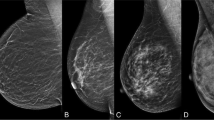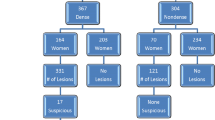Abstract
Purpose
We investigated the usefulness of abbreviated breast MRI (AB-MRI), including fat-suppressed T2-weighted imaging, pre- and postcontrast image acquisition, and subtracted maximum-intensity projection imaging, for the screening of women with a history of breast cancer surgery.
Methods
Between October 2014 and March 2016, a total of 799 AB-MRI examinations were performed for 725 women with a history of breast cancer surgery. The image acquisition time was 8.5 min. Screening mammography, ultrasound, and AB-MRI were generally performed around the same time. The cancer detection rate, positive predictive values for recall and biopsy, sensitivity and specificity of screening MRI, and rate of malignancy belonging to each breast imaging reporting and data system (BI-RADS) category were assessed.
Results
AB-MRI detected 12 malignancies in 12 women (15.0 cancers per 1000 cases). Seven of these 12 malignancies were initially invisible on ultrasound and mammography, although subsequent targeted ultrasound revealed lesions corresponding to the MRI-detected lesions. The positive predictive values for recall and biopsy and sensitivity and specificity values for screening MRI were 12.4, 61.5, 100, and 89.2%, respectively. The rates of malignancies belonging to categories 1, 2, 3, and 4 of the BI-RADS were 0, 0, 4.8, and 57.1%, respectively.
Conclusions
The diagnostic performance of screening AB-MRI for women with a history of breast cancer surgery is acceptable, with the advantages of short examination and interpretation times and low costs. Thus, it could be used as a main screening modality that may replace conventional imaging in breast cancer survivors.


Similar content being viewed by others
Change history
14 November 2017
In the original publication of the article, the acknowledgment section was missed out inadvertently. The acknowledgement section is below
References
Fisher B, Anderson S, Bryant J et al (2002) Twenty-year follow-up of a randomized trial comparing total mastectomy, lumpectomy, and lumpectomy plus irradiation for the treatment of invasive breast cancer. N Engl J Med 347:1233–1241
Veronesi U, Cascinelli N, Mariani L et al (2002) Twenty-year follow-up of a randomized study comparing breast-conserving surgery with radical mastectomy for early breast cancer. N Engl J Med 347:1227–1232
Anderson SJ, Wapnir I, Dignam JJ et al (2009) Prognosis after ipsilateral breast tumor recurrence and locoregional recurrences in patients treated by breast-conserving therapy in five national surgical adjuvant breast and bowel project protocols of node-negative breast cancer. J Clin Oncol 27:2466–2473
Gao X, Fisher SG, Emami B (2003) Risk of second primary cancer in the contralateral breast in women treated for early-stage breast cancer: a population-based study. Int J Radiat Oncol Biol Phys 56:1038–1045
Houssami N, Ciatto S, Martinelli F et al (2009) Early detection of second breast cancers improves prognosis in breast cancer survivors. Ann Oncol 20:1505–1510
Dershaw DD, Shank B, Reisinger S (1987) Mammographic findings after breast cancer treatment with local excision and definitive irradiation. Radiology 164:455–461
De la Rochefordière A, Mouret-Fourme E, Asselain B et al (1996) Metachronous contralateral breast cancer as first event of relapse. Int J Radiat Oncol Biol Phys 36:615–621
Kollias J, Evans AJ, Wilson ARM et al (2000) Value of contralateral surveillance mammography for primary breast cancer follow-up. World J Surg 24:983–989
Hill-Kayser CE, Harris EE, Hwang W et al (2006) Twenty-year incidence and patterns of contralateral breast cancer after breast conservation treatment with radiation. Int J Radiat Oncol Biol Phys 66:1313–1319
Robinson A, Speers C, Olivotto I et al (2007) Method of detection of new contralateral primary breast cancer in younger versus older women. Clin Breast Cancer 7:705–709
Weinstock C, Bigenwald R, Hochman T et al (2012) Outcomes of surveillance for contralateral breast cancer in patients less than age 60 at the time of initial diagnosis. Curr Oncol 19:e160–e164
Orel SG, Troupin RH, Patterson EA et al (1992) Breast cancer recurrence after lumpectomy and irradiation: role of mammography in detection. Radiology 183:201–206
Grosse A, Schreer I, Frischbier H et al (1997) Results of breast conserving therapy for early breast cancer and the role of mammographic follow-up. Int J Radiat Oncol Biol Phys 38:761–767
Ashkanani F, Sarkar T, Needham G et al (2001) What is achieved by mammographic surveillance after breast conservation treatment for breast cancer? Am J Surg 182:207–210
Joseph E, Hyacinthe M, Lyman GH et al (1998) Evaluation of an intensive strategy for follow-up and surveillance of primary breast cancer. Ann Surg Oncol 5:522–528
Gweon HM, Cho N, Han W et al (2014) Breast MR imaging screening in women with a history of breast conservation therapy. Radiology 272:366–373
Brennan S, Liberman L, Dershaw DD et al (2010) Breast MRI screening of women with a personal history of breast cancer. Am J Roentgenol 195:510–516
Kuhl CK, Schrading S, Strobel K et al (2014) Abbreviated breast magnetic resonance imaging (MRI): first postcontrast subtracted images and maximum-intensity projection—a novel approach to breast cancer screening with MRI. J Clin Oncol 32:2304–2310
D’Orsi CJ (2013) ACR BI-RADS atlas: breast imaging reporting and data system
American College of Radiology (2003) Breast imaging reporting and data system atlas (BI-RADS atlas). American College of Radiology 98, Reston
Eby PR, DeMartini WB, Gutierrez RL et al (2009) Characteristics of probably benign breast MRI lesions. Am J Roentgenol 193:861–867
Eby PR, DeMartini WB, Gutierrez RL et al (2010) Probably benign lesions detected on breast MR imaging. Magn Reson Imaging Clin N Am 18:309–321
Berg WA, Zhang Z, Lehrer D et al (2012) Detection of breast cancer with addition of annual screening ultrasound or a single screening MRI to mammography in women with elevated breast cancer risk. JAMA 307:1394–1404
Cho N, Han W, Han BK et al (2017) Breast cancer screening with mammography plus ultrasonography or magnetic resonance imaging in women 50 years or younger at diagnosis and treated with breast conservation therapy. JAMA Oncol. doi:10.1001/jamaoncol.2017.1256
Schacht DV, Yamaguchi K, Lai J et al (2014) Importance of a personal history of breast cancer as a risk factor for the development of subsequent breast cancer: results from screening breast MRI. Am J Roentgenol 202:289–292
Giess CS, Poole PS, Chikarmane SA et al (2015) Screening breast MRI in patients previously treated for breast cancer: diagnostic yield for cancer and abnormal interpretation rate. Acad Radiol 22:1331–1337
Weinstock C, Campassi C, Goloubeva O et al (2015) Breast magnetic resonance imaging (MRI) surveillance in breast cancer survivors. SpringerPlus 4:459
Lehman CD, Lee JM, DeMartini WB et al (2016) Screening MRI in women with a personal history of breast cancer. J Natl Cancer Inst 108:djv349
Bevers TB, Anderson BO, Bonaccio E et al (2009) NCCN clinical practice guidelines in oncology: breast cancer screening and diagnosis. J Natl Compr Canc Netw 7:1060–1096
Khatcheressian JL, Wolff AC, Smith TJ et al (2006) American society of clinical oncology 2006 update of the breast cancer follow-up and management guidelines in the adjuvant setting. J Clin Oncol 24:5091–5097
Bennani-Baiti B, Baltzer PA (2017) MR imaging for diagnosis of malignancy in mammographic microcalcifications: a systematic review and meta-analysis. Radiology 283:692–701
Ballesio L, Savelli S, Angeletti M et al (2010) Breast MRI: are T2 IR sequences useful in the evaluation of breast lesions? Clin Imaging 34:77
Kuhl CK, Klaschik S, Mielcarek P et al (1999) Do T2-weighted pulse sequences help with the differential diagnosis of enhancing lesions in dynamic breast MRI? J Magn Reson Imaging 9:187–196
Mann RM, Kuhl CK, Kinkel K et al (2008) Breast MRI: guidelines from the European society of breast imaging. Eur Radiol 18:1307–1318
Heacock L, Melsaether AN, Heller SL et al (2016) Evaluation of a known breast cancer using an abbreviated breast MRI protocol: correlation of imaging characteristics and pathology with lesion detection and conspicuity. Eur J Radiol 85:815–823
Erbas B, Provenzano E, Armes J et al (2006) The natural history of ductal carcinoma in situ of the breast: a review. Breast Cancer Res Treat 97:135–144
Sanders ME, Schuyler PA, Dupont WD et al (2005) The natural history of low-grade ductal carcinoma in situ of the breast in women treated by biopsy only revealed over 30 years of long-term follow-up. Cancer 103:2481–2484
Abe H, Mori N, Tsuchiya K et al (2016) Kinetic analysis of benign and malignant breast lesions with ultrafast dynamic contrast-enhanced MRI: comparison with standard kinetic assessment. Am J Roentgenol 207:1159–1166
Morrison CK, Henze Bancroft LC, DeMartini WB et al (2017) Novel high spatiotemporal resolution versus standard-of-care dynamic contrast-enhanced breast MRI: comparison of image quality. Invest Radiol 52:198–205
Author information
Authors and Affiliations
Corresponding author
Ethics declarations
Conflicts of interest
The authors declare that they have no conflict of interest.
Additional information
A correction to this article is available online at https://doi.org/10.1007/s10549-017-4568-y.
Rights and permissions
About this article
Cite this article
Choi, B.H., Choi, N., Kim, M.Y. et al. Usefulness of abbreviated breast MRI screening for women with a history of breast cancer surgery. Breast Cancer Res Treat 167, 495–502 (2018). https://doi.org/10.1007/s10549-017-4530-z
Received:
Accepted:
Published:
Issue Date:
DOI: https://doi.org/10.1007/s10549-017-4530-z




